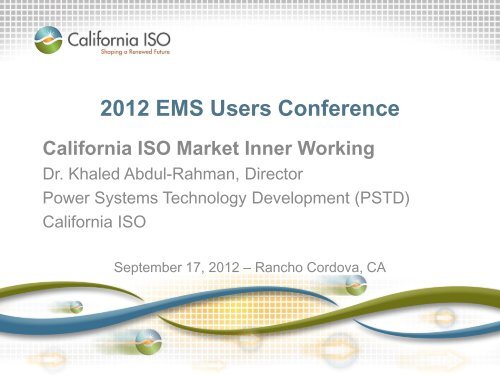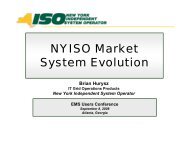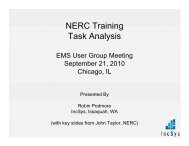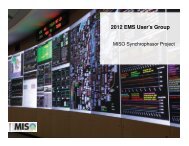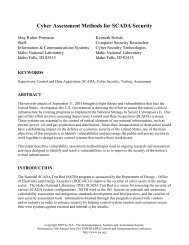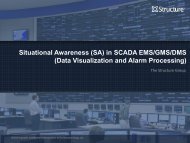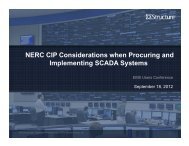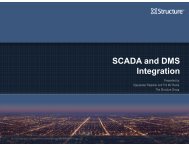CAISO Market Inner Working - EMS Users Conference
CAISO Market Inner Working - EMS Users Conference
CAISO Market Inner Working - EMS Users Conference
You also want an ePaper? Increase the reach of your titles
YUMPU automatically turns print PDFs into web optimized ePapers that Google loves.
2012 <strong>EMS</strong> <strong>Users</strong> <strong>Conference</strong><br />
California ISO <strong>Market</strong> <strong>Inner</strong> <strong>Working</strong><br />
Dr. Khaled Abdul-Rahman, Director<br />
Power Systems Technology Development (PSTD)<br />
California ISO<br />
September 17, 2012 – Rancho Cordova, CA<br />
ISO PUBLIC © 2012 <strong>CAISO</strong>
Topics<br />
� <strong>CAISO</strong> Grid and <strong>Market</strong> Processes<br />
� Full Network Model and <strong>CAISO</strong>’s Use of CIM Standards<br />
� Balancing Supply and Demand<br />
� Flexible Fleet Capabilities<br />
� Non-Generation Resources (LESR, DDR)<br />
� Need for More Effective Operational Tools<br />
� On-Going Enhancements<br />
� Future Key Enhancement<br />
ISO PUBLIC © 2012 <strong>CAISO</strong><br />
Slide 2
California ISO LMP <strong>Market</strong><br />
� On April 1, 2009, <strong>CAISO</strong> started its new LMP market<br />
� The objective of the co-optimization is to balance net<br />
expected demand with net expected supply at minimum<br />
cost while observing physical characteristics of<br />
resources and grid reliability constraints.<br />
� The optimized unit commitment and dispatch levels may<br />
be sufficient to satisfy the expected system condition.<br />
� To the extent imbalance conditions vary from the<br />
expected condition, sufficient flexibility must be<br />
committed to respond to such variations.<br />
ISO PUBLIC © 2012 <strong>CAISO</strong><br />
Slide 3
California ISO by the numbers<br />
ISO PUBLIC © 2012 <strong>CAISO</strong><br />
� 57,963 MW of power plant<br />
capacity<br />
� 50,270 MW record peak demand<br />
(July 24, 2006)<br />
� 30,000 market transactions<br />
per day<br />
� 25,865 circuit-miles of<br />
transmission lines<br />
� 30 million people served<br />
� 286 million megawatt-hours of<br />
electricity delivered annually<br />
Slide 4
California ISO in WECC<br />
� Largest of 37 Balancing Authorities in the West<br />
� 38 intertie points with neighboring systems<br />
� Managing 80% of California load<br />
� Represent 30% of the Western Interconnection load<br />
ISO PUBLIC © 2012 <strong>CAISO</strong><br />
Slide 5
ISO Resource Mix<br />
14.6% - hydro, geothermal,<br />
biomass, wind, solar<br />
* In addition to 29% Net Imports<br />
1.7% - coal<br />
14.6% - large hydro<br />
15.7% - nuclear<br />
53.4% - natural gas<br />
ISO PUBLIC © 2012 <strong>CAISO</strong><br />
Source: California Energy Commission<br />
Slide 6
ISO PUBLIC © 2012 <strong>CAISO</strong><br />
Source: www.caiso.com<br />
Slide 7
Variable Generation Locations<br />
ISO PUBLIC © 2012 <strong>CAISO</strong><br />
Slide 8
Balancing Supply and Demand<br />
ISO PUBLIC © 2012 <strong>CAISO</strong><br />
Slide 9
<strong>CAISO</strong> <strong>Market</strong> Processes<br />
Real<br />
Time<br />
Real Time 5-<br />
Min Dispatch<br />
<strong>Market</strong><br />
Hour Ahead<br />
Process and<br />
Real Time<br />
Unit<br />
Commitment<br />
ISO PUBLIC © 2012 <strong>CAISO</strong><br />
Day Ahead<br />
<strong>Market</strong><br />
Pre-Day<br />
Ahead<br />
Activities<br />
Process<br />
Begins<br />
Slide 10
Real Time<br />
� Process generation and transmission outages<br />
� RA replacement<br />
Real Time 5-<br />
Min Dispatch<br />
<strong>Market</strong><br />
� Model transmission constraints<br />
� Forecast next day’s hourly load<br />
� Commit long-start units<br />
Hour Ahead<br />
Process and<br />
Real Time<br />
Unit<br />
Commitment<br />
� Medium to Long Term: CRR auctions, RMR, Transmission<br />
Planning, economic transmission projects assessment<br />
ISO PUBLIC © 2012 <strong>CAISO</strong><br />
Day Ahead<br />
<strong>Market</strong><br />
Pre-Day<br />
Ahead<br />
Activities<br />
Slide 11
Real Time<br />
Real Time 5-<br />
Min Dispatch<br />
<strong>Market</strong><br />
� Receive and process bids<br />
Hour Ahead<br />
Process and<br />
Real Time<br />
Unit<br />
Commitment<br />
� Mitigate market power (MPM)<br />
ISO PUBLIC © 2012 <strong>CAISO</strong><br />
Day Ahead<br />
<strong>Market</strong><br />
Pre-Day<br />
Ahead<br />
Activities<br />
� Clear energy supply & demand including virtual bids and<br />
procure ancillary services (IFM)<br />
� Commit additional capacity to meet load forecast (RUC)<br />
� Issue hourly operating schedules and day ahead prices<br />
Slide 12
Real Time<br />
Real Time 5-<br />
Min Dispatch<br />
<strong>Market</strong><br />
Hour Ahead<br />
and Real<br />
Time Unit<br />
Commitment<br />
� Receive and process bids<br />
� Mitigate market power (MPM)<br />
ISO PUBLIC © 2012 <strong>CAISO</strong><br />
Day Ahead<br />
<strong>Market</strong><br />
Pre-Day<br />
Ahead<br />
Activities<br />
� Schedule interchange with adjacent areas (HASP)<br />
� Procure additional ancillary services (RTUC)<br />
� Commit short start resources (RTUC)<br />
Slide 13
Real Time<br />
Real Time 5-<br />
Min<br />
Dispatch<br />
<strong>Market</strong><br />
Hour Ahead<br />
Process and<br />
Real Time<br />
Unit<br />
Commitment<br />
� Issue 5-min dispatch instructions for generators and<br />
participating load<br />
� Set and publish 5-minute prices<br />
� Issue exceptional dispatches, if needed<br />
� Issue 10-min contingency dispatch instructions (RTCD)<br />
ISO PUBLIC © 2012 <strong>CAISO</strong><br />
Day Ahead<br />
<strong>Market</strong><br />
Pre-Day<br />
Ahead<br />
Activities<br />
Slide 14
Real Time<br />
Real Time 5-<br />
Min Dispatch<br />
<strong>Market</strong><br />
Hour Ahead<br />
Process and<br />
Real Time<br />
Unit<br />
Commitment<br />
ISO PUBLIC © 2012 <strong>CAISO</strong><br />
Day Ahead<br />
<strong>Market</strong><br />
� Resources respond to dispatch instructions<br />
� Monitor minute-to-minute conditions<br />
Pre-Day<br />
Ahead<br />
Activities<br />
� Deviations within the 5-min time intervals are balanced<br />
through dispatch of regulation capacity reserve via AGC<br />
� Operators intervene only when needed<br />
Slide 15
<strong>CAISO</strong> <strong>Market</strong> Temporal Hierarchy<br />
ISO PUBLIC © 2012 <strong>CAISO</strong><br />
Slide 16
Full Network Model<br />
� <strong>CAISO</strong> maintains two separate network models using CIM<br />
Standards:<br />
o Grid reliability network model used by <strong>EMS</strong><br />
o <strong>Market</strong> Network model used by IFM/RTM and CRR<br />
o Same detailed representation inside California ISO<br />
Control Area<br />
� Various vendor systems and many legacy systems were<br />
integrated leveraging SOA technology and adopting IEC<br />
CIM standard as communication platform<br />
� <strong>CAISO</strong> needed to extend the IEC CIM standards 61970,<br />
61968 and CME to define various market related data and<br />
messages<br />
ISO PUBLIC © 2012 <strong>CAISO</strong><br />
Slide 17
Examples of CIM and its Extension at <strong>CAISO</strong><br />
� Modeling of Reference Data<br />
Standard CIM classes have been extended for the modeling of quasi-static<br />
data to support the <strong>CAISO</strong> markets<br />
� Example: Registered Resources<br />
o Three major resource types in <strong>CAISO</strong>: generator, load and inter-tie<br />
o CME classes re-used to create an extension representing the inter-tie<br />
resource<br />
� Example: Multi-Stage Generator (MSG)<br />
o MSG concept models resources with more than two operating states<br />
o Represents an extensions of the two-state (on/off) model for generating<br />
units<br />
� Example: Pricing Node<br />
o A Pnode is directly associated with a ConnectivityNode<br />
o <strong>CAISO</strong> extended CIM to define a new class AggregatedPnode – to<br />
represent pricing hub, zones or aggregated resource<br />
ISO PUBLIC © 2012 <strong>CAISO</strong><br />
Slide 18
Balancing Supply and Demand<br />
Many factors influence balancing supply and demand.<br />
ISO PUBLIC © 2012 <strong>CAISO</strong><br />
Reserve<br />
Supply<br />
Demand<br />
Slide 19
<strong>CAISO</strong> Needs for Flexible Fleet Capability<br />
� <strong>CAISO</strong> needs more flexible measures to balance the increasingly<br />
weather-dependent (variable) generation and other uncertainties<br />
associated with load as well as changing operational system<br />
conditions.<br />
� <strong>CAISO</strong> has observed that the unit commitment and position of<br />
resources in the 15-min RTUC may lack sufficient ramping capability<br />
and flexibility to meet system conditions for the 5-min RTD during<br />
which conditions may have changed from the assumptions made<br />
during the prior 15-min pre-dispatch.<br />
� Shortage of ramping following capability may result in:<br />
o Leaning on the interconnection<br />
o RTD energy price is not priced by economic bids, but by<br />
administrative penalty prices, which may impact market<br />
efficiency in the long run<br />
ISO PUBLIC © 2012 <strong>CAISO</strong><br />
Slide 20
Non-Generation Resources - Limited Energy Storage<br />
Resource (LESR)<br />
� Based on simulation results, the addition of faster<br />
regulation resources can improve the average CPS1<br />
scores when compared to the base case results while<br />
keeping the same regulation requirements.<br />
� Simulation results also suggest that CPS1 performance<br />
can be maintained near base case levels while<br />
reducing the regulation requirements with the addition<br />
of fast resources.<br />
� The results also indicate diminishing returns for levels<br />
of fast resources beyond certain percentages that are<br />
power system dependent.<br />
ISO PUBLIC © 2012 <strong>CAISO</strong><br />
Slide 21
Load Leveling using Storage<br />
Natural Load (MW)<br />
Load with Battery (MW)<br />
Battery Operating Profile<br />
Charge Charge<br />
Discharge Discharge<br />
ISO PUBLIC © 2012 <strong>CAISO</strong><br />
Slide 22
Renewable Stabilization<br />
Solar variability<br />
Storage charge/discharge by AGC<br />
ISO PUBLIC © 2012 <strong>CAISO</strong><br />
Smooth Solar output<br />
Slide 23
ACE shaping<br />
MW<br />
5.000<br />
4.000<br />
3.000<br />
2.000<br />
1.000<br />
0.000<br />
-1.000<br />
-2.000<br />
-3.000<br />
-4.000<br />
-5.000<br />
=/- 4 MW Regulation Scaled to 250 MW ACE Signal<br />
299<br />
309<br />
319<br />
329<br />
339<br />
349<br />
359<br />
369<br />
379<br />
389<br />
399<br />
409<br />
419<br />
429<br />
439<br />
449<br />
459<br />
469<br />
479<br />
Time (Minutes)<br />
ISO PUBLIC © 2012 <strong>CAISO</strong><br />
489<br />
499<br />
509<br />
519<br />
529<br />
539<br />
549<br />
559<br />
569<br />
579<br />
589<br />
599<br />
Charge<br />
Discharge<br />
Slide 24
Non-Generation Resources – Dispatchable Demand<br />
Response (DDR)<br />
� For many people, curtailing load a few times a year in reaction to<br />
peak demands on the power system is “demand response” – Not<br />
enough!<br />
� Demand Response refers to all methods in which demand side<br />
assets can react to the needs of the power system<br />
� Demand response are already participating in operating reserves!<br />
� New and more intelligent technologies enable loads to participate in<br />
many more forms:<br />
o Regulation Services<br />
o Flexible Ramp<br />
o Localized DR<br />
o T & D upgrade deferral<br />
ISO PUBLIC © 2012 <strong>CAISO</strong><br />
Slide 25
What Do We Need From DDR?<br />
� One of the key promises of “the smart grid” is much<br />
tighter integration of loads with the needs of the<br />
power system<br />
� As DRs participate in ways more integral to the grid<br />
needs, they must respond:<br />
o Faster (seconds and minutes not hours and days)<br />
o More frequent (constant adjustment)<br />
o Bi-directional (grid balance)<br />
� Technology must exist to limit the impact to the end<br />
customer (inherent flexibility and operational constraints)<br />
ISO PUBLIC © 2012 <strong>CAISO</strong><br />
Slide 26
Need for More Effective Operational Tools<br />
Voltage instability - progressive and uncontrollable decline in voltage<br />
after disturbance, increase in load demand, or change in other system<br />
conditions, often results in system disintegration or blackout.<br />
� Increased power transfers across interfaces<br />
� Increased intermittent renewable resources in the grid<br />
� Need effective control tools due to minute by minute<br />
decisions<br />
� Limits calculated in planning studies are not accurate<br />
enough due to unplanned outages and de-ratings<br />
� Sudden fluctuations of supply and net load due to<br />
intermittent renewable generators, DER, load forecast<br />
uncertainty, uninstructed dispatch deviations<br />
� System Operator needs new tools<br />
ISO PUBLIC © 2012 <strong>CAISO</strong><br />
Slide 27
Situational Awareness Tools<br />
� PI Displays (along with <strong>EMS</strong> displays)<br />
� Real-Time VSA<br />
� Real-Time DSA (in the plan)<br />
� RTDMS (PMU measurements – Real-Time Dynamics<br />
Monitoring System)<br />
� Renewables watch (Weather, wind speeds, renewable<br />
generation)<br />
� Monitor Fires in the area (Google Earth Maps)<br />
ISO PUBLIC © 2012 <strong>CAISO</strong><br />
Slide 28
On-Line Voltage Stability Analysis (VSA) Tool<br />
� <strong>EMS</strong> System and On-Line VSA Integration<br />
o SE solutions as base case<br />
o Fully automatic with High Availability (HA)<br />
o Operational since 6/09<br />
� Importance of <strong>Market</strong> System and Look-Ahead VSA Integration<br />
o Integrated VSA with market system may verify the system<br />
conditions as set out in the DAM or RTM to provide better<br />
situational awareness of the security of the system and the<br />
operating limits<br />
o VSA can potentially allow the transmission limits found in offline<br />
studies to be updated based on the current network model<br />
conditions, thus allowing the ISO to operate the grid at lower cost<br />
and the consumers to reap the benefit of lower market pricing.<br />
ISO PUBLIC © 2012 <strong>CAISO</strong><br />
Slide 29
Integrated <strong>Market</strong> System and VSA-LA Design Features<br />
� Seamless Integration with <strong>Market</strong> and <strong>EMS</strong> systems<br />
� Fast Contingency screening and Ranking<br />
� Renewable Resources Volatility Simulation<br />
� Control Actions Recommendations<br />
� Real Time <strong>Market</strong> Look Ahead <strong>Market</strong> Verification<br />
� Day Ahead <strong>Market</strong> (DAM) Verification<br />
� Study Mode for “What-If” Analysis<br />
ISO PUBLIC © 2012 <strong>CAISO</strong><br />
Slide 30
VSA-RT Geographical Interface Margin Display<br />
ISO PUBLIC © 2012 <strong>CAISO</strong><br />
Slide 31
Sample VSA-DA Results: Area X Load Margin<br />
for Two Different Trading Days<br />
3400<br />
3200<br />
3000<br />
2800<br />
2600<br />
2400<br />
2200<br />
2000<br />
Area X Load Margin from VSA-DA<br />
0 4 8 12 16 20 24<br />
ISO PUBLIC © 2012 <strong>CAISO</strong><br />
Slide 32
Sample VSA-DA study Results - Load Margin Trend Curve for DAM<br />
ISO PUBLIC © 2012 <strong>CAISO</strong><br />
Slide 33
Some Ongoing Enhancements<br />
� <strong>Market</strong> Operator Training Simulator (MOTS)<br />
� Enhanced Contingency Analysis in <strong>Market</strong> Apps<br />
� Optimal Scheduling of Small Size Resources<br />
� Integrated IFM and RUC<br />
� Transmission and Generation Outage Coordination Tool<br />
� Forecasting Enhancements (load, gen, DER, ramping, reg, spin, ns)<br />
� Visualization Tools<br />
ISO PUBLIC © 2012 <strong>CAISO</strong><br />
Slide 34
Future Network Applications Key Enhancements<br />
� Expanded <strong>Market</strong> Network Model<br />
� DC Lines Modeling<br />
� Dynamic Line Ratings<br />
� Voltage Schedules & Reactive Power Controls<br />
� Topology Error Estimation<br />
� Islanding Operation Support<br />
ISO PUBLIC © 2012 <strong>CAISO</strong><br />
Slide 35
Future <strong>Market</strong> Applications Key Enhancements<br />
� Transmission Reservation to Support Dynamic Transfer<br />
� Flexible Ramp Product<br />
� Mileage Requirement Model to support Pay-For-<br />
Performance<br />
� Expand NGR Model to Include DR, EV, Micro-grid,<br />
Virtual Plant Model<br />
� Price Sensitive Demand Response<br />
� Model Impact of Gas Network Constraints in the <strong>Market</strong><br />
ISO PUBLIC © 2012 <strong>CAISO</strong><br />
Slide 36
Q & A<br />
For more follow up questions, please contact:<br />
Dr. Khaled Abdul-Rahman<br />
kabdul@caiso.com<br />
Thank You<br />
ISO PUBLIC © 2012 <strong>CAISO</strong><br />
Slide 37


